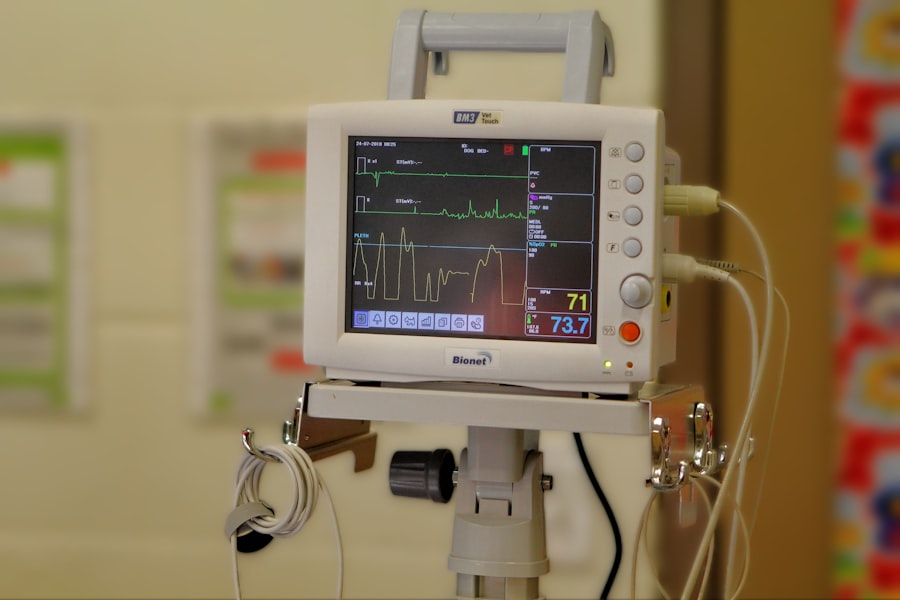The advent of artificial intelligence (AI) has revolutionized numerous sectors, and healthcare is no exception. AI-based patient monitoring systems are at the forefront of this transformation, offering innovative solutions that enhance the quality of care provided to patients. These systems leverage advanced algorithms and machine learning techniques to continuously track vital signs and other health indicators, enabling healthcare professionals to make informed decisions swiftly.
As the demand for efficient and effective patient care grows, the integration of AI into monitoring systems presents a promising avenue for improving outcomes and streamlining processes. In recent years, the healthcare industry has witnessed a surge in the adoption of AI technologies, particularly in patient monitoring. Traditional methods often rely on manual data collection and interpretation, which can be time-consuming and prone to human error.
In contrast, AI-based systems automate these processes, providing real-time insights that can significantly enhance patient safety. By harnessing the power of big data and predictive analytics, these systems not only monitor patients’ health but also anticipate potential complications before they arise, thereby transforming the landscape of patient care. AI systems are revolutionizing industries, for more information visit AI systems.
Key Takeaways
- AI-based patient monitoring uses advanced technology to continuously track and analyze vital signs, providing real-time insights into a patient’s health status.
- Continuous vital sign monitoring allows for early detection of any abnormalities or changes in a patient’s condition, enabling prompt medical intervention.
- AI algorithms can quickly and accurately detect anomalies in vital signs, such as irregular heartbeats or abnormal blood pressure, alerting medical staff to take immediate action.
- The real-time alerts generated by AI-based patient monitoring systems enable medical staff to respond swiftly to any changes in a patient’s condition, potentially saving lives.
- The benefits of AI-based patient monitoring include improved patient outcomes, reduced healthcare costs, and enhanced efficiency in healthcare delivery, ultimately leading to better patient care.
Continuous Vital Sign Monitoring
Continuous vital sign monitoring is a cornerstone of AI-based patient monitoring systems. These systems utilize a variety of sensors and wearable devices to collect data on critical health parameters such as heart rate, blood pressure, respiratory rate, and oxygen saturation. Unlike traditional monitoring methods that may only capture snapshots of a patient’s condition at specific intervals, continuous monitoring provides a comprehensive view of a patient’s health status over time.
This constant stream of data allows healthcare providers to detect subtle changes that may indicate deterioration or improvement in a patient’s condition. The integration of AI into continuous monitoring systems enhances their capabilities significantly. Machine learning algorithms can analyze vast amounts of data in real-time, identifying patterns and trends that may not be immediately apparent to human observers.
For instance, an AI system can learn from historical patient data to establish baseline readings for individual patients, enabling it to flag deviations that could signify potential health issues. This level of personalized monitoring not only improves the accuracy of assessments but also empowers healthcare providers to intervene proactively, ultimately leading to better patient outcomes.
Real-Time Detection of Anomalies

One of the most compelling features of AI-based patient monitoring is its ability to detect anomalies in real-time. Traditional monitoring systems often rely on preset thresholds to identify concerning changes in a patient’s vital signs. However, these thresholds may not account for individual variability or the complex interplay of multiple health factors.
AI algorithms, on the other hand, can analyze data in a more nuanced manner, taking into consideration a patient’s unique medical history and current condition. By employing advanced techniques such as anomaly detection and predictive modeling, AI systems can identify irregularities that may indicate an impending crisis. For example, if a patient’s heart rate suddenly spikes or drops outside of their established baseline, the AI system can alert medical staff immediately.
This rapid response capability is crucial in critical care settings where every second counts. Moreover, the ability to continuously learn from new data means that these systems become increasingly adept at recognizing patterns over time, further enhancing their effectiveness in anomaly detection.
Alerting Medical Staff
The efficacy of AI-based patient monitoring systems hinges not only on their ability to collect and analyze data but also on their capacity to communicate critical information to medical staff promptly. When an anomaly is detected, the system must alert healthcare providers in real-time to ensure timely intervention. This is typically achieved through a combination of visual alerts on monitoring screens and notifications sent directly to mobile devices or pagers used by medical personnel.
The design of these alert systems is crucial; they must balance urgency with clarity to avoid alert fatigue among staff members. Overly frequent or non-specific alerts can lead to desensitization, causing medical professionals to overlook genuine emergencies. To mitigate this risk, many AI-based systems employ sophisticated algorithms that prioritize alerts based on the severity of the detected anomaly and its potential impact on patient safety.
By ensuring that only the most critical alerts are communicated immediately, these systems help maintain a high level of vigilance among healthcare providers while minimizing unnecessary distractions.
Benefits of AI-based Patient Monitoring
The benefits of AI-based patient monitoring are manifold and extend beyond mere efficiency gains. One of the most significant advantages is the potential for improved patient outcomes. By providing continuous monitoring and real-time anomaly detection, these systems enable healthcare providers to respond swiftly to changes in a patient’s condition, reducing the likelihood of complications and hospital readmissions.
In addition to enhancing patient safety, AI-based monitoring systems can also lead to cost savings for healthcare institutions. By automating routine tasks such as data collection and analysis, these systems free up valuable time for medical staff, allowing them to focus on direct patient care.
Moreover, early detection of health issues can prevent costly interventions down the line, ultimately contributing to more efficient resource allocation within healthcare facilities. As hospitals and clinics continue to grapple with rising operational costs, the financial benefits of implementing AI-based monitoring solutions become increasingly compelling.
Challenges and Limitations

Despite the numerous advantages offered by AI-based patient monitoring systems, several challenges and limitations must be addressed for widespread adoption. One significant concern is data privacy and security. The continuous collection and transmission of sensitive health information raise questions about how this data is stored and protected from unauthorized access.
Healthcare organizations must navigate complex regulatory frameworks while ensuring that patient confidentiality is maintained at all times. Another challenge lies in the integration of AI systems with existing healthcare infrastructure. Many hospitals still rely on legacy systems that may not be compatible with modern AI technologies.
This lack of interoperability can hinder the seamless flow of information between different platforms, limiting the effectiveness of AI-driven monitoring solutions. Additionally, there is a need for ongoing training and education for healthcare professionals to ensure they are equipped to interpret AI-generated insights effectively and incorporate them into their clinical decision-making processes.
Future Developments in AI-based Patient Monitoring
As technology continues to evolve at a rapid pace, the future of AI-based patient monitoring holds exciting possibilities. One area poised for significant advancement is the integration of wearable technology with AI algorithms. Wearable devices equipped with sensors capable of tracking a wide range of health metrics are becoming increasingly sophisticated.
As these devices become more prevalent among patients, they will provide a wealth of real-time data that can be analyzed by AI systems to offer even more personalized insights into individual health trends. Moreover, advancements in natural language processing (NLP) could enhance the way healthcare providers interact with AI systems. By enabling clinicians to communicate with monitoring systems using natural language queries, NLP could streamline workflows and facilitate more intuitive access to critical information.
This would empower medical staff to make informed decisions quickly without needing extensive training on complex software interfaces.
The Impact of AI on Patient Care
In conclusion, AI-based patient monitoring represents a transformative force in healthcare that has the potential to significantly improve patient care outcomes. By enabling continuous vital sign monitoring, real-time anomaly detection, and timely alerts for medical staff, these systems enhance both efficiency and safety within clinical settings.
As we look ahead, it is clear that the impact of AI on patient care will only continue to grow. The combination of wearable technology, advanced analytics, and natural language processing will pave the way for even more sophisticated monitoring solutions that empower healthcare providers to deliver personalized care at scale. Ultimately, as AI continues to evolve and integrate into everyday clinical practice, it holds the promise of not only improving individual patient outcomes but also transforming the entire landscape of healthcare delivery for the better.
AI-based patient monitoring is revolutionizing healthcare by providing continuous vital sign monitoring, real-time detection of anomalies, and alerting medical staff when necessary. This technology has the potential to greatly improve patient outcomes and reduce healthcare costs. For more information on the economic and social impacts of AI in healthcare, check out this article on Metaverse and the Real World: Economic and Social Impacts.
FAQs
What is AI-based patient monitoring?
AI-based patient monitoring refers to the use of artificial intelligence technology to continuously track and analyze a patient’s vital signs, such as heart rate, blood pressure, and oxygen levels, in real-time. This technology can detect anomalies and alert medical staff to potential issues, allowing for early intervention and improved patient outcomes.
How does AI-based patient monitoring work?
AI-based patient monitoring systems use sensors and wearable devices to collect data on a patient’s vital signs. This data is then analyzed by AI algorithms to identify patterns and detect any abnormalities. When an anomaly is detected, the system can automatically alert medical staff, enabling them to intervene promptly.
What are the benefits of AI-based patient monitoring?
AI-based patient monitoring offers several benefits, including continuous real-time monitoring of vital signs, early detection of potential health issues, and timely alerts to medical staff. This can lead to improved patient outcomes, reduced hospital stays, and better resource allocation within healthcare facilities.
What are the challenges of AI-based patient monitoring?
Challenges of AI-based patient monitoring include ensuring the accuracy and reliability of the AI algorithms, addressing privacy and security concerns related to patient data, and integrating these systems into existing healthcare workflows. Additionally, there may be concerns about the potential for over-reliance on technology and the need for human oversight.
How is AI-based patient monitoring being used in healthcare?
AI-based patient monitoring is being used in various healthcare settings, including hospitals, clinics, and home care. These systems are used to monitor patients with chronic conditions, post-operative patients, and those at risk of deteriorating health. The technology is also being integrated into telemedicine platforms to enable remote monitoring of patients.











Leave a Reply